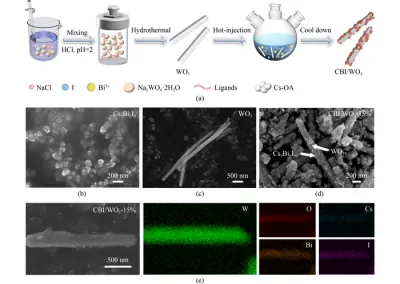
Revolutionizing CO2 Reduction: A Breakthrough in Solar Energy with New Photocatalyst
2025-07-03
Author: Rajesh
A Game-Changer in Sustainable Energy
As global energy demands surge and environmental issues intensify, the race is on to develop sustainable technologies that effectively convert and utilize carbon dioxide (CO2). Among the most promising methods is photocatalytic CO2 reduction, which harnesses solar energy to transform CO2 into valuable chemicals. Yet, traditional photocatalysts struggle with challenges like poor light absorption and ineffective charge separation.
The Rise of Metal Halide Perovskites
Metal halide perovskites have emerged as star players in photocatalysis, celebrated for their exceptional light absorption and charge transport capabilities. However, lead-based perovskites are plagued by degradation issues and toxicity, steering researchers toward safer, lead-free alternatives like bismuth (Bi) materials. One standout candidate is Cs3Bi2I9, a lead-free halide perovskite known for its impressive optoelectronic performance but hampered by aggregation and limited oxidation ability.
Innovative Design by Xi'an Jiaotong University
In a groundbreaking study, a research team spearheaded by Jie Chen at Xi’an Jiaotong University has unveiled a cutting-edge photocatalyst—a Z-scheme heterojunction composed of 0D Cs3Bi2I9 nanoparticles integrated with 1D WO3 nanorods, tailored for CO2 reduction under visible light. This novel catalyst was synthesized using an in situ growth method, ensuring the nanoparticles seamlessly integrated with the nanorods.
Stunning Results from Enhanced Photocatalytic Activity
The 0D/1D Cs3Bi2I9/WO3 heterojunction has demonstrated outstanding photocatalytic CO2 reduction capabilities. Notable achievements include an impressive CO production rate of 16.5 µmol/(g·h)—three times greater than that of traditional Cs3Bi2I9, which only achieved 5.3 µmol/(g·h)—with a remarkable CO selectivity of 98.7%.
Unprecedented Stability and Charge Transfer Mechanisms
Stability is a key highlight of this innovative photocatalyst. It retained consistent performance over three cycles of 3-hour reactions, exhibiting no significant structural degradation. Furthermore, through advanced techniques such as in situ X-ray photoelectron spectroscopy (XPS) and electron spin resonance (ESR), researchers have unveiled a Z-scheme charge transfer mechanism, where electrons are efficiently transferred from WO3 to Cs3Bi2I9 under light, enhancing charge separation and minimizing recombination.
Paving the Way for Future Innovations
This research not only sheds light on the design of superior heterojunctions for CO2 reduction but also heralds a new age of advanced photocatalysts. By combining morphological engineering with Z-scheme design principles, the study unlocks pathways for the development of more efficient and stable materials, thereby playing a pivotal role in the quest for sustainable energy solutions and carbon emission reduction.



 Brasil (PT)
Brasil (PT)
 Canada (EN)
Canada (EN)
 Chile (ES)
Chile (ES)
 Česko (CS)
Česko (CS)
 대한민국 (KO)
대한민국 (KO)
 España (ES)
España (ES)
 France (FR)
France (FR)
 Hong Kong (EN)
Hong Kong (EN)
 Italia (IT)
Italia (IT)
 日本 (JA)
日本 (JA)
 Magyarország (HU)
Magyarország (HU)
 Norge (NO)
Norge (NO)
 Polska (PL)
Polska (PL)
 Schweiz (DE)
Schweiz (DE)
 Singapore (EN)
Singapore (EN)
 Sverige (SV)
Sverige (SV)
 Suomi (FI)
Suomi (FI)
 Türkiye (TR)
Türkiye (TR)
 الإمارات العربية المتحدة (AR)
الإمارات العربية المتحدة (AR)